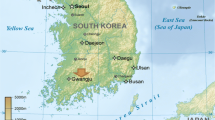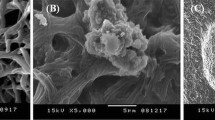Abstract
Actinobacteria isolated from poorly explored biotopes are of interest as producers of biologically active compounds. A report is given about the producer of lydicamycin Je 1–6 isolated from the rhizosphere soil of J. excelsa Bieb. collected from the Crimean Peninsula, Ukraine, that demonstrated its antagonistic activity against gram-positive bacteria. Based on the 16S rRNA gene sequence analysis, the strain Je 1–6 was affiliated to the Streptomyces genus. The crude extract from the biomass of this strain showed its activity against gram-positive bacteria, including polyresistant clinical isolates of Staphylococcus sp. The dereplication analysis of the extract of the strain Je 1–6 revealed lydicamycin and its congeners: 30-demethyllydicamycin, 30-demethyl-8-deoxylydicamycin, and 8-deoxylydicamycin. MLSA analysis based on the 16S rRNA gene and five housekeeping genes atpD, gyrB, rpoB, recA, and trpB of the strain Je 1–6 showed a high level of homology with Streptomyces sp. ID38640.




Similar content being viewed by others
REFERENCES
Ahmad, M.S., El-Gendy, A.O., Ahmed, R.R., et al., Exploring the antimicrobial and antitumor potentials of Streptomyces sp. AGM12-1 isolated from Egyptian soil, Front. Microbiol., 2017, vol. 8, p. 438. https://doi.org/10.3389/fmicb.2017.00438
Aminov, R., History of antimicrobial drug discovery: major classes and health impact, Biochem. Pharmacol., 2017, vol. 133, pp. 4–19. https://doi.org/10.1016/j.bcp.2016.10.001
Bauer, A.W., Kirby, W.M., Sherris, J.C., et al., Antibiotic susceptibility testing by a standardized single disk method, Am. J. Clin. Pathol., 1996, vol. 45, pp. 493–496.
Bilyk, O., Sekurova, O.N., Zotchev, S.B., et al., Cloning and heterologous expression of the grecocycline bio-synthetic gene cluster, PLoS One, 2016, vol. 11, no. 7. e0158682. https://doi.org/10.1371/journal.pone.0158682
Buckingham, J., Dictionary of Natural Products, London: CRC Press/Taylor and Francis Group, 1993.
Edgar, R.C., MUSCLE: multiple sequence alignment with high accuracy and high throughput, Nucleic Acids Res., 2004, vol. 32, pp. 1792–1797. https://doi.org/10.1093/nar/gkh340
Felsenstein, J., Evolutionary trees from DNA sequences: a maximum likelihood approach, J. Mol. Evol., 1981, vol. 17, pp. 368–376.
Felsenstein, J., Confidence limits on phylogenies: an approach using the bootstrap, Evolution, 1985, vol. 39, pp. 783–791.
Furumai, T., Eto, K., Sasaki, T., et al., TPU-0037-A, B, C and D, novel lydicamycin congeners with anti-MRSA activity from Streptomyces platensis TP-A0598, J. Antibiot., 2002, vol. 55, no. 10, pp. 873–880. https://doi.org/10.7164/an-tibiotics.55.873
Genilloud, O., Actinomycetes: still a source of novel antibiotics, Nat. Prod. Rep., 2017, vol. 34, pp. 1203–1232. https://doi.org/10.1039/c7np00026j
Goodfellow, M. and Williams, S., Ecology of actinomycetes, Ann. Rev. Microbiol., 1983, vol. 37, pp. 189–216.
Guo, Y., Zheng, W., Rong, X., et al., A multilocus phylogeny of the Streptomyces griseus 16S rRNA gene clade: use of multilocus sequence analysis for streptomycete systematics, Int. J. Syst. Evol. Microbiol., 2008, vol. 58, pp. 149–159. https://doi.org/10.1099/ijs.0.65224-0
Hayakawa, Y., Kanamaru, N., Shimazu, A., et al., Lydicamycin, a new antibiotic of a novel skeletal type. I. Taxonomy, fermentation, isolation and biological activity, J. Antibiot., 1991, vol. 44, no. 3, pp. 282–287.
Khamna, S., Yokota, A., and Lumyong, S., Actinomycetes isolated from medicinal plant rhizosphere soils: diversity and screening of antifungal compounds, indole-3-acetic acid and siderophore production, World J. Microbiol. Biotechnol., 2009, vol. 25, pp. 649–655. https://doi.org/10.1007/s11274-008-9933-x
Kieser, B., Buttner, M., Charter, K., and Hopwood, B., Practical Streptomyces Genetics, Norwich: John Innes Foundation, 2000.
Kimura, M., A simple method for estimating evolutionary rates of base substitutions through comparative studies of nucleotide sequences, J. Mol. Evol., 1980, vol. 16, pp. 111–120.
Komaki, H., Hosoyama, A., Igarashi, Y., et al., Streptomyces lydicamycinicus sp. nov. and its secondary metabolite biosynthetic gene clusters for polyketide and nonribosomal peptide compounds, Microorganisms, 2020, vol. 8, no. 3, p. 370. https://doi.org/10.3390/microorganisms8030370
Kostyanev, T. and Can, F., The global crisis of antimicrobial resistance, in Antimicrobial Stewardship, 1st ed., Pulcini, C., Ergonul, O., Can, F., and Beovic, B., Eds., Cambridge: Academic Press, 2017, pp. 3–12.
Kumar, S., Stecher, G., Li, M., et al., MEGA X: molecular evolutionary genetics analysis across computing platforms, Mol. Biol. Evol., 2018, vol. 35, no. 6, pp. 1547–1549. https://doi.org/10.1093/molbev/msy096
Labeda, D.P., Doroghazi, J.R., Ju, K.S., et al., Taxonomic evaluation of Streptomyces albus and related species using multilocus sequence analysis and proposals to emend the description of Streptomyces albus and describe Streptomyces pathocidini sp. nov., Int. J. Syst. Evol. Microbiol., 2014, vol. 64, pp. 894–900. https://doi.org/10.1099/ijs.0.058107-0
Liu, D., Yan, R., Fu, Y., et al., Antifungal, plant growth-promoting, and genomic properties of an endophytic actinobacterium Streptomyces sp. NEAU-S7GS2, Front. Microbiol., 2019, vol. 10, p. 2077. https://doi.org/10.3389/fmicb.2019.02077
Maciejewska, M., Pessi, I.S., Arguelles-Arias, A., et al., Streptomyces lunaelactis sp. nov., a novel ferroverdin A-producing Streptomyces species isolated from a moonmilk speleothem, Antonie van Leeuwenhoek, 2015, vol. 107, pp. 519–531. https://doi.org/10.1007/s10482-014-0348-4
Raju, R., Gromyko, O., Fedorenko, V., et al., Juniperolide A: a new polyketide isolated from a terrestrial actinomycete, Streptomyces sp., Org. Lett., 2012a, vol. 14, no. 23, pp. 5860–5863. https://doi.org/10.1021/ol302766z
Raju, R., Gromyko, O., Fedorenko, V., et al., Leopolic acid A, isolated from a terrestrial actinomycete, Streptomyces sp., Tetrahedron Lett., 2012b, vol. 53, pp. 6300–6301. https://doi.org/10.1016/j.tetlet.2012.09.046
Rebets, Y., Ostash, B., Luzhetskyy, A., et al., Production of landomycins in Streptomyces globisporus 1912 and S. cyanogenus S136 is regulated by genes encoding putative transcriptional activators, FEMS Microbiol. Lett., 2003, vol. 222, pp. 149–153. https://doi.org/10.1016/S0378-1097(03)00258-1
Rong, X. and Huang, Y., Taxonomic evaluation of the Streptomyces hygroscopicus clade using multilocus sequence analysis and DNA–DNA hybridization, validating the MLSA scheme for systematics of the whole genus, Syst. Appl. Microbiol., 2012, vol. 35, no. 1, pp. 7–18. https://doi.org/10.1016/j.syapm.2011.10.004
Running, W., Computer software reviews, Chapman and Hall Dictionary of Natural Products on CD-ROM, J. Chem. Inf. Model., 1993, vol. 33, pp. 934–935.
Saitou, N. and Nei, M., The neighbor-joining method: a new method for reconstructing phylogenetic trees, Mol. Biol. Evol., 1987, vol. 4, pp. 406–425.
Sosio, M., Gaspari, E., Iorio, M., et al., Analysis of the Pseudouridimycin biosynthetic pathway provides insights into the formation of C-nucleoside antibiotics, Cell Chem. Biol., 2018, vol. 25, pp. 540–549. https://doi.org/10.1016/j.chembiol.2018.02.008
Ventola, C.L., The antibiotic resistance crisis, part 1: causes and threats, P&T, 2015, vol. 40, no. 4, pp. 277–283.
Viaene, T., Langendries, S., Beirinckx, S., et al., Streptomyces as a plant’s best friend?, FEMS Microbiol. Ecol., 2016, vol. 92, no. 8. fiw119. https://doi.org/10.1093/femsec/fiw119
Wang, Q., Garrity, G.M., Tiedje, J.M., et al., Naive Bayesian classifier for rapid assignment of rRNA sequences into the new bacterial taxonomy, Appl. Environ. Microbiol., 2016, vol. 73, pp. 5261–5267. https://doi.org/10.1128/AEM.00062-07
Funding
This study was supported by the grant H/309-2003 of the Ministry of Education and Science of Ukraine (V. Fedorenko, O. Gromyko), the state budget project of the Ministry of Health of Ukraine (O. Korniychuk, I. Tymchuk), and partially supported by the individual grant FEMS-GO- 2017-001 for S. Tistechok.
Author information
Authors and Affiliations
Corresponding author
Ethics declarations
The authors declare that they have no conflict of interests. This article does not contain any studies involving animals or human participants performed by any of the authors.
Additional information
Translated by V. Mittova
About this article
Cite this article
Tistechok, S.I., Tymchuk, I.V., Korniychuk, O.P. et al. Genetic Identification and Antimicrobial Activity of Streptomyces sp. Strain Je 1–6 Isolated from Rhizosphere Soil of Juniperus excelsa Bieb. Cytol. Genet. 55, 28–35 (2021). https://doi.org/10.3103/S0095452721010138
Received:
Revised:
Accepted:
Published:
Issue Date:
DOI: https://doi.org/10.3103/S0095452721010138




